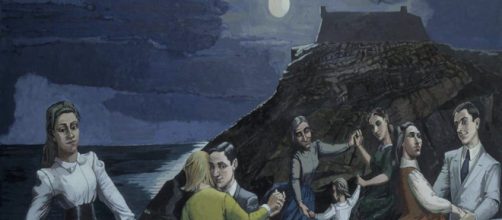“From today, painting is dead.” So go the famous words of 19th-century history-painter Paul Delaroche when he saw photography enter the art scene.
His was no wild prediction given photographer Andres Serrano’s eventual National Endowment for the Arts award for sticking a small crucifix in a jar of his urine and calling it Piss Christ. But painting never really died. Shock art like Serrano’s just stole the spotlight for a while. Tate Britain’s retrospective of figurative artist Paula Rego’s body of work, set to open this week, leaves no doubt that painting lives.
Inside out
Rego’s imagery of mostly female figures has been called feminist. But the stories she tells of equal parts suffering and strength seem darker than any social movement. I’m thinking of Dog Women,” a vision of such howling heartache that words describing it don’t work. As Rego told The Observer reporter Kate Kellaway, “You discover things in the making of a painting. It can reveal things that you didn’t expect. Things you keep secret from yourself.”
The Guardian art critic Jonathan Jones gets it, and imagines that the wrenched women dominating Rego’s pictures “dictated by an invisible man, grunting commands.” But as charged as his words are, they don’t explain what you see.
He admits this, saying that her pictures are “disturbingly impossible to resolve.”
Twisted sister?
British art critic Alistair Sooke, writing for the Telegraph, holds an altogether different view of Rego’s pictures, and with such anger that it borders on woman-hating. He begins by minimizing her as “a fierce deity for the MeToo generation,” and slighting her figures as “stubborn senhoritas” – a reference to her Portuguese background.
Sooke, apparently standing in for all males, makes the pain in Rego’s work his, not hers. for what he sees as male-bashing and her faulting men for “abusing women, controlling and manipulating them, denying their natural desires.” To make sure you see how vicious she is, Sooke says that in the gender wars, “she is a five-star general, an Amazonian queen, feminism’s avenging angel.” Clearly, he forgets that Rego was raised under the António de Oliveira Salazar’s dictatorship.
If she’s bashing anything, it’s censorship and those who police it.
How different are the views of Britain’s leading art critics? Let me count the ways with this one example, Rego’s painting The Policeman’s Daughter. As you look at the daughter polishing her father’s high black boot, it’s useful to remember how crushing it was for free-spirited Rego to live under Salazar’s rule.
Daddy issues
What you see in the daughter’s polishing effort is one of her arms extended so far inside the boot that it nearly envelopes her. And because her eyes are on the task you can’t tell what she’s thinking. Jones sees her closed-off expression as an emblem for an “oppressive, dishonest society where kinky complications accumulate like dust on a patriarch’s boot.” Sooke sees the girl “doing something obscene to her daddy’s leather boot.” No surprise there.
What he sees in all of Rego’s works are “wicked children, driven by rebellious instincts, thwarted sexual urges, and murderous impulses.”
Say what?
But wait, Sooke ends his review on a positive note, as if he thought better of shooting down Rego’s entire retro as some whiney female complaint. While taking one more crack at disparaging her work, calling it’s “excessively illustrative,” he concludes “this is an excellent exhibition.” Go figure.


